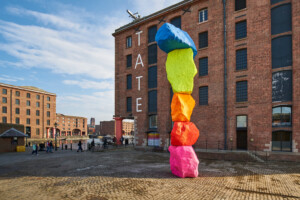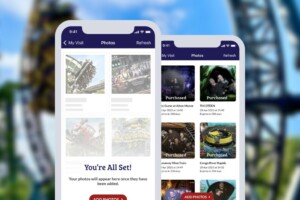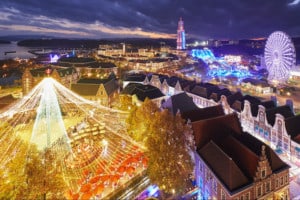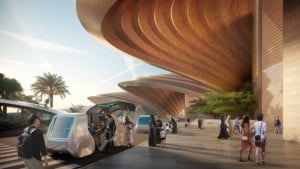Related: Themed Designer Rhetroactive is the Gold Sponsor of the Official IAAPA Mobile App/ Merlin Entertainments: LEGOLAND Windsor Hotel Review/ Universal Orlando Resort’s Despicable Me Minion Mayhem 3D Ride Opens July 2nd / Harry Potter at the Warner Bros. Studio Tour London: Could it be Magic?
Tim Rheault and Steve Trowbridge are passionate about Retail, Food & Beverage and Hospitality. They spent nearly 15  years working alongside Gary Goddard, first at Landmark Entertainment Group, then later as founding members of the Goddard Group. For 10 years Steve and Tim were two of three Creative Directors, for Retail and Hospitality respectively, and worked on projects worldwide including the Galaxy Macau and Tropicana Las Vegas Resort, as well as most of the Hershey Company’s branded experiences.
years working alongside Gary Goddard, first at Landmark Entertainment Group, then later as founding members of the Goddard Group. For 10 years Steve and Tim were two of three Creative Directors, for Retail and Hospitality respectively, and worked on projects worldwide including the Galaxy Macau and Tropicana Las Vegas Resort, as well as most of the Hershey Company’s branded experiences.
With a deepening interest in creating innovative retail, dining, hospitality and location based entertainment experiences, Tim and Steve recently spun off RHETROACTIVE, originally born as a boutique lab within Goddard Group in 2004.
RHETROACTIVE has developed several Retail, F&B and Hospitality concept for the leisure market, most recently consulting on the Despicable Me: Minion Mayhem store at Universal Orlando..jpg)
Steve and Tim talk to Blooloop about the significant trends that they see for the future for Retail, Food & Beverage and Hospitality in the attractions industry and beyond.
Why did you choose to focus on Retail, Food & Beverage and Hospitality?
Most people in the theme park industry want to work in the attractions side of things — the more exciting work — but it’s a relatively limited market with a lot of competition. Retail, F&B and Hospitality however, are key components of theme park resorts – exceeding half the revenue per capita. They’re also necessary in the supporting facilities of a theme park or destination resort or even a city – everyone needs a place to eat, sleep and shop.
But what we’re doing with RHETROACTIVE is bringing a “leisure design process” to a lot of the more mainstream projects we’re developing in the Retail, F&B and Hospitality sectors as well. Taking an experience and narrative based design approach has the potential to be successful across all of those sectors. In the day and age of internet shopping, eating and even virtual travelling, customers have become more much sophisticated and seek deeper, more engaging experiences when they go out of the house.
What are the trends you’re seeing in Food and Beverage?
Food & Beverage in theme parks is the second or third most important spend for guests so they’re expecting higher end, more immersive experiences overall, from the theming and décor to the backstory and menu.
In Las Vegas, F&B and Retail has actually overtaken gambling revenue. We think it’s going t o be the same in theme parks. It’s an important experience that needs to be focussed on.
o be the same in theme parks. It’s an important experience that needs to be focussed on.
Likewise people are expecting a more theme-park-like experience when they go out. What you’re going to see is exactly what’s happening with concepts like the Bubba Gump Shrimp Company – taking existing IPs and creating experiences around story lines that allow people to connect with the brand in new and interesting ways.
We also think that there will be a lot more themed restaurant experiences; not quite like the 80-90’s with a handful of ‘Hard Rock Café’ wannabes that didn’t quite work well, but more evolved experiences. Probably more focussed on brands that connect people to things that they’ve seen or experienced.
At the same time, it sounds ironic but a certain level of authenticity is increasingly important. Even though some of these restaurants are based on fictional back-stories, at the end of the day, service and quality have to be good and there has to be an authentic experience.
Looking at operations is the key to everything that goes into the guest experience. The front of house is what guests experience directly, but it’s important to know how things work behind the scenes. So in the same way that when you’re designing an attraction it’s only as good as the technology and mechanics behind it, what we do very well is understand the mechanics of the back-of-house, which allows us to design a higher quality experience for the guest.
Many operators are bringing in typical fast-food chains into parks (we won’t mention any names), but we think that’s actually the opposite of what people are looking for in Theme Parks. Yes, people recognise those brands, but at the same time they can go to those stores any day of the week. There needs to be signature dining experiences, unique to the park. Night-time shows and parades are designed to keep people in the park longer, and we think that there’s also an opportunity to make the dining experience a key component in extending the guest’s stay.
 What about healthier eating?
What about healthier eating?
We actually just opened the prototype store for Daily Juice. They’re a great little healthy, nurturing juice bar out of Austin Texas who have 3 sites currently but are hoping to roll out 100 over the next 4 years. We went to their current locations and found what could be their key market differentiator. Unlike their competitors, everything was so fresh; it was healthy looking and colourful but the preparation of the produce and production of the drinks were at the back of the house out of sight. The freshness and quality of the product they were preparing were so key, so we designed the store bringing those processes closer to the guest, not just to make the operation more efficient, but also to make the process and the freshness, colour and quality of the products a focus in what we’re calling the ‘prep theatre’. It is a completely different approach than what you will see at Jamba Juice or Starbuck Corporation’s new Evolution Fresh stores.
In an interesting twist, we’ve been asked by Daily Juice how they can enter into the theme park market, at Disney in particular, because of Disney’s partnership with Michelle Obama’s “Let’s Move!” campaign. This is one area where we’re on the front line and these are very early conversations. It will be interesting to see if Disney does take the lead and whether Universal, Six Flags and other operators will follow. It will also be interesting to see how Disney will make meaningful changes to on-property dining and how the public will respond.
… and children’s menus?
It seems children are only allowed to eat chicken nuggets and pizza! We’d love to do something much more creative with kids’ menus especially at theme parks and resort hotels. Children need to be eating health ier and what better a place to star than theme parks.
ier and what better a place to star than theme parks.
What are some trends you’re seeing in Hospitality?
This is an area we really think there’s a huge opportunity for lodging and family hotel operators in the surrounding areas of theme parks to elevate their experiences.
Disney is one of the few theme park operators that own and operate their hotels and obviously they have laser focused initiates in this area. We think that there’s an opportunity for us to engage hotels near theme parks and attractions, whether accessed directly through the hotel flags, or offered from IP holders selling packages that franchise hotels could apply to some of their room inventory or a complete property that’s nearby a theme park. We’re hoping to bridge the gap between the hotel/motel/lodging industry and the attractions industry.
We think that this is a really interesting emerging area, especially with the success of Disney’s off site hotels; Great Wolf Lodge’s staycation experience; ‘Shrek and Friends’ at Gaylord Hotels and Merlin’s success with LEGOLAND hotels.
The key message that we want hotel operators to understand is that it’s not difficult or expensive for that matter. It’s just applying a light layer of theming to augment the family experience at their hotels.
 On the other end of the spectrum, there’s fully integrated hotels attached to theme parks and attractions. Right before we left Goddard Group we had the opportunity to lead the creative design and planning of the hotel and conference center portion of the Fushun Dreamworld project, which is currently under construction in China. There we created what really aims to be a Disney-quality resort attached to a retail promenade, which connects to the park. It’s definitely an impactful design and if theme park operators can invest in hospitality at this scale, we certainly encourage it.
On the other end of the spectrum, there’s fully integrated hotels attached to theme parks and attractions. Right before we left Goddard Group we had the opportunity to lead the creative design and planning of the hotel and conference center portion of the Fushun Dreamworld project, which is currently under construction in China. There we created what really aims to be a Disney-quality resort attached to a retail promenade, which connects to the park. It’s definitely an impactful design and if theme park operators can invest in hospitality at this scale, we certainly encourage it.
In addition, we are also working with a couple of major Hollywood Studios to apply their IPs to some context overlays within the hospitality market. Look out for more developments in this area.
What impact do you think Disney’s Aulani Resort will have?
Disney is already the leader in the industry. They’ve been doing it well with their Vacation Club properties for years. Of course taking into account the local culture is also important and Disney has done a great job in conveying the local culture into a Disney resort experience. Aulani is a more authentic experience with an overlay of the Disney charm and quality that guests expect.
 People are travelling much more with kids and flying longer distances than they ever have in the past. When they get there they want that sort of experience. The Disney cruise line is another example where they’re having a great level of success; it’s a real surprise that other entertainment companies aren’t picking up on this more. It’s an untapped market.
People are travelling much more with kids and flying longer distances than they ever have in the past. When they get there they want that sort of experience. The Disney cruise line is another example where they’re having a great level of success; it’s a real surprise that other entertainment companies aren’t picking up on this more. It’s an untapped market.
We really believe that family hotels are the next big thing. Boutique and business-centric hotels were huge over the last couple of decades but there is going to be a much bigger focus on family hotels in the future.
And where do you see the future Retail going?
In the theme park world what we tried to do for Despicable Me: Minion Mayhem was to create an extended experience that’s emotionally engaging and gets people to spend more time and money with the brand. We think you’ll see much more of this in theme parks, zoos and aquariums.
An attraction gets people to the theme park, but then how do you get people to spend more of their hard earned dollars in the park? For us the obvious solution is a great Retail experience – getting people to spend more by creating environments where people see the value of buying something that will ultimately extend the memories beyond the park. The retail experience should be as good as the attraction.
How do you accomplish this?
 In Despicable Me, a memorable moment in the movie is when the little girl holds the cute, cuddly unicorn in the scene where they go to Super Silly Fun Land. So Universal asked us to recreate that scene for the Retail environment.
In Despicable Me, a memorable moment in the movie is when the little girl holds the cute, cuddly unicorn in the scene where they go to Super Silly Fun Land. So Universal asked us to recreate that scene for the Retail environment.
Similarly, everything Universal did at the Wizarding World of Harry Potter™, including Ollivanders™ (the wand shop) is a really great retail concept that hadn’t been done before; creating memorable moments from the movies that people can connect with.
The important part in all three of our core sectors actually is that inside a theme park or attraction we need to be delivering an experience or product that you can’t get anywhere else. If the stuffed animal plush or T-shirt is something that you can buy at JC Penny then that’s not very novel. But things like Harry Potter’s wand or Butter Beer are products that are uniquely suited to be sold inside the Wizarding World and have a really special appeal as a souvenir.
And again we’re aiming to bridge the gap between theme parks and attractions and the mainstream retail, so with some of those retail projects we’re consulting on, we’re trying to bring in some theme park concepts into those experiences. At the same time some of the things that we see in mainstream retail would be great to apply in theme park retail.
With the Hershey store in Time Square is a great example of creating a unique experience. You can buy Hershey’s products anywhere but we created an environment that was original; an experience that you don’t get buying your Hershey bar at the local Walgreens.
 In fact, you can pretty much buy anything you want online so why do people want to go to a store at all? What it comes down to is whether you can create a really great environment. American Girl Place and Build-A-Bear are two excellent examples that provide great experiences that allow people to get into the brand and experience it in an environment that they can’t experience anywhere else. American Girl Place is interesting because it has an F&B operation within it. Girls come back and have lunch with their best friends and mothers so it goes beyond the simple act of purchasing a doll. It’s a deeper experience that encourages a social interaction that feels special and hence creates a high return rate. You’re going to see a lot more of that happening.
In fact, you can pretty much buy anything you want online so why do people want to go to a store at all? What it comes down to is whether you can create a really great environment. American Girl Place and Build-A-Bear are two excellent examples that provide great experiences that allow people to get into the brand and experience it in an environment that they can’t experience anywhere else. American Girl Place is interesting because it has an F&B operation within it. Girls come back and have lunch with their best friends and mothers so it goes beyond the simple act of purchasing a doll. It’s a deeper experience that encourages a social interaction that feels special and hence creates a high return rate. You’re going to see a lot more of that happening.
It’s funny to see a lot of mainstream retailers going in the direction of Apple and creating a really stark store hoping that if they build a store that looks exactly like an Apple store they will perform well. The problem is that Apple has really engaging products under the spotlight on that very stark stage; their products are the star. Every brand has to have a unique environment for their product but not everyone is going to benefit from doing a white store with slate flooring. There’s an opportunity for brands to create environments that reflect the product but also augment the overall shopping experience. An environment that allows those products to be showcased is really beneficial.
What is the bottom line?
Almost every architecture, design and branding firm out there is using the term ‘creating emotionally engaging experiences’ now, but we’ve done it since the late 90s. We have a unique perspective, having been entrenched in the theme park and attractions world as well as the Retail, F&B and Hospitality worlds. We really believe these sectors are becoming more and more aligned every day. There’s an opportunity for theme parks and mainstream retailers, eateries and hotels alike to create immersive experiences and we’re hoping to bring that expertise to them.
Images: Girl with fluffy unicorn at Despicable Me: Minion Mayhem which is © 2012 Universal Orlando Resort. All rights reserved. Despicable Me: Minion Mayhem developed in conjunction with Universal Creative











